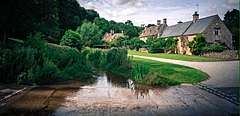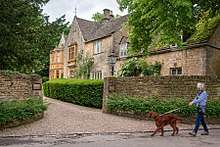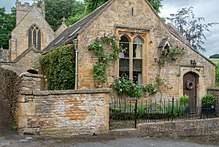Upper Slaughter
Upper Slaughter is a village in the Cotswold district of Gloucestershire, England, 4 miles (6.4 km) south west of Stow-on-the-Wold. Nearby places include Lower Slaughter, Bourton-on-the-Water and Daylesford.
| Upper Slaughter | |
|---|---|
 Upper Slaughter | |
 Upper Slaughter Location within Gloucestershire | |
| Population | 177 (2011)[1] |
| OS grid reference | SP154231 |
| Civil parish |
|
| District |
|
| Shire county | |
| Region | |
| Country | England |
| Sovereign state | United Kingdom |
| Post town | CHELTENHAM |
| Postcode district | GL54 |
| Dialling code | 01451 |
| Police | Gloucestershire |
| Fire | Gloucestershire |
| Ambulance | South Western |
| UK Parliament |
|
The village is built on both banks of the River Eye. The Anglican parish church is dedicated to St. Peter.[2][3]
Upper Slaughter was one of the Thankful Villages,[4] amongst the small number in England which lost no men in World War I.[5] The village also lost no men in World War II, an honour known as a Doubly Thankful Village.[5][6]

The parliamentary constituency is represented by Geoffrey Clifton-Brown MP.

History
The name of the village derives from the Old English term "slough" meaning "wet land".[7]
The manor of Upper Slaughter is recorded in the Domesday Book of 1086; the Slaughter family acquired it in the late 12th century. The current building, on the site of an ancient building, was constructed over many years, starting in the Tudor era. Its crypt is estimated to be from the 14th century.[8]
Upper Slaughter was the site of an adulterine castle, built by supporters of the Empress Matilda during The Anarchy of the 12th century. The remains of the castle are marked by the Castle Mound on the north edge of the village.
The largest business in the village is the Lords of the Manor Hotel. The building dates from 1649 and has been a hotel since 1960s, furnished with portraits and antiques belonging to the former owner.[9] Other hotels serving the two Slaughter villages include The Slaughters Country Inn and Lower Slaughter Manor.
In 1906, the cottages around the square were reconstructed by architect Sir Edward Lutyens.
On the night of February 4th 1944 during Operation Steinbock a Luftwaffe bomber dropped 2000 incendiary bombs on Upper Slaughter. Despite some buildings sustaining damage there were no fatalities or injuries.
Architecture

Places of architectural interest include:
- St Peter's Church
- Upper Slaughter Manor
- Home Farmhouse
- The Old School House
- Castle Mound
- Rose Row
- The Square
Gallery
 Upper Slaughter Manor from the side
Upper Slaughter Manor from the side- Upper Slaughter Church
- The River Eye
- The old school
- Rose Cottages
References
![]()
- "Parish population 2015". Retrieved 25 March 2015.
- The Buildings of England, ed Nikolaus_Pevsner
- Elrington, C. R. (1965). A History of the County of Gloucester: volume 6. pp. 134–142.
- "The thankful villages by Norman Thorpe, Rod Morris and Tom Morgan". Hellfirecorner.co.uk. Retrieved 9 June 2013.
- Kelly, Jon (11 November 2011). "Thankful villages: The places where everyone came back from the wars". BBC News. Retrieved 11 November 2011.
- "Parishes - Upper Slaughter | A History of the County of Gloucester: volume 6 (pp. 134–142)". British-history.ac.uk. 4 October 1913. Retrieved 9 June 2013.
- The Cotswolds
- Upper Slaughter Manor
- The Telegraph
- The Buildings of England Gloucestershire 1: The Cotswolds, David Verey and Alan Brooks, Penguin Books 1999